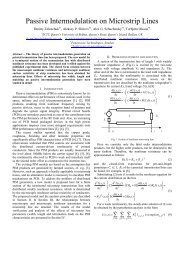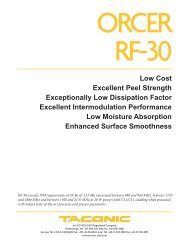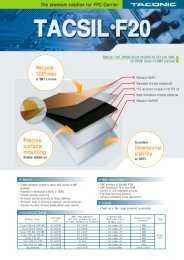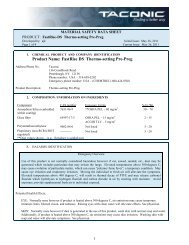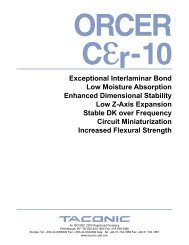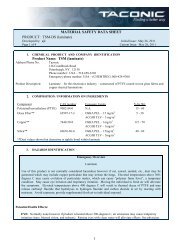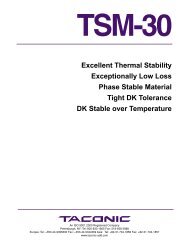improving wearable slot antenna performance with ebg ... - Taconic
improving wearable slot antenna performance with ebg ... - Taconic
improving wearable slot antenna performance with ebg ... - Taconic
You also want an ePaper? Increase the reach of your titles
YUMPU automatically turns print PDFs into web optimized ePapers that Google loves.
2008 Loughborough Antennas & Propagation Conference 17-18 March 2008, Loughborough, UK<br />
phantom, the resonant frequency is around 2.75 GHz by the detuning effect. When the EBG structure<br />
<strong>antenna</strong> is placed on the phantom, the resonant frequency stays at 2.85 GHz, the bandwidth decreases<br />
to 100 MHz, which is caused by the strong coupling effect by only a 1 mm separation between the <strong>slot</strong><br />
<strong>antenna</strong> and the EBG surface. (EBG6 means the EBG structure <strong>with</strong> 6×6 elements and EBG4 for 4×4<br />
elements). For comparison we placed a PEC reflector instead of the EBG and in this case there is no<br />
apparent resonant frequency and S<br />
11<br />
is above -10dB from 2.6 GHz to 3.2 GHz.<br />
3.2 Efficiency and Radiation Pattern<br />
As signal absorption occurs in close proximity to the human body, the <strong>antenna</strong> efficiency has become<br />
the key parameter in our design. Fig. 4 indicates the <strong>antenna</strong> efficiency in different scenarios. As<br />
illustrated in Fig. 4, the <strong>slot</strong> <strong>antenna</strong> in free space has an efficiency of η a = 95%while <strong>with</strong> the <strong>antenna</strong><br />
5 mm away from the human body, the efficiency becomes η a = 16% and η a = 10% <strong>with</strong> a PEC<br />
reflector. However, when an EBG is applied under the <strong>slot</strong> <strong>antenna</strong>, the <strong>antenna</strong> efficiency is η a = 76%<br />
for a 6×6 element EBG and 67% for a 4×4 element EBG which has a 50%-60% improvement<br />
compared to the <strong>antenna</strong> <strong>with</strong>out EBG. The improvements arise from the characteristic of in-phase<br />
reflection and surface wave suppression thus it effectively isolates the <strong>slot</strong> <strong>antenna</strong> from the<br />
surrounding environments.<br />
Return Loss(dB)<br />
0<br />
2.6 2.7 2.8 2.9 3 3.1 3.2<br />
-5<br />
-10<br />
-15<br />
-20<br />
-25<br />
-30<br />
-35<br />
-40<br />
Frequency(GHZ)<br />
Free space<br />
Phantom<br />
EBG6+Phantom<br />
EBG4+Phantom<br />
PEC+Phantom<br />
Antenna Efficiency<br />
1<br />
0.9<br />
0.8<br />
0.7<br />
0.6<br />
0.5<br />
0.4<br />
0.3<br />
0.2<br />
0.1<br />
0<br />
free space<br />
Phantom<br />
EBG6+Phantom<br />
EBG4+Phantom<br />
PEC+Phantom<br />
2.6 2.7 2.8 2.9 3 3.1 3.2<br />
Frequency(GHz)<br />
(a)<br />
Fig. 4 (a) Measured Return Loss from 2.6 to 3.2 GHz (b) Measured Antenna Efficiency from 2.6 to 3.2<br />
GHz<br />
(b)<br />
(a) (b) (c)<br />
Fig. 5 Simulated Radiation Pattern (a) free space (b) On Phantom w/o EBG (c) On Phantom w EBG<br />
3.3 The separation effect between the <strong>antenna</strong> and EBG surface<br />
In previous experiments, we set the gap h between the <strong>slot</strong> <strong>antenna</strong> to the EBG surface to be 1mm<br />
which makes sure the whole structure is more compact. To indicate the separation effect, we adjust the<br />
gap h between 2 mm and 3 mm. The simulation (h=*mm_S) and measurement (h=*mm_M) results<br />
are shown in Fig. 6.<br />
175



